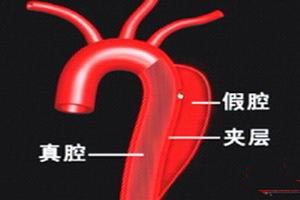病,提之畏惧,因其凶险,若问外科疾病凶险排名,它一定“榜上有名”——主动脉夹层。上榜理由不言而喻,主动脉是体循环的动脉主干,可谓是人体的大中枢!以下6问6答为大家揭秘此“凶首“!
 作者:北京清华长庚医院血管外科赵克强
作者:北京清华长庚医院血管外科赵克强 1、什么是主动脉夹层?
主动脉壁存在或不存在自身病变的基础上,并在一系列外因(高血压、外伤等)的作用下导致主动脉内膜撕裂,血液由内膜裂口进入主动脉壁中层,造成主动脉中层沿长轴分离,从而使主动脉管腔呈现真假腔的病理状态。
2、主动脉夹层有多凶险?
急性夹层动脉瘤的患者可突然发生死亡或在数小时或数天内发生死亡。荟萃文献中夹层动脉瘤的患者,发现其中50%在48小时内死亡,每小时死亡的危险占1%。70%死于1周内,90%死于3个月内。早期死亡的主要原因是瘤体破裂导致大出血休克死亡或重要器官供血动脉的阻塞,如冠状动脉、颈动脉或内脏动脉。
3、再感受一下凶险:主动脉夹层主要有哪些临床症状?
在实际情况中可以表现为不同的情况,主要包括以下几点:
1)典型的急性主动脉夹层病人往往表现为突发的、剧烈的、胸背部、撕裂样疼痛。严重的可以出现心衰、晕厥、甚至突然死亡;多数患者同时伴有难以控制的高血压;
2) 主动脉分支动脉闭塞可导致相应的脑、肢体、肾脏、腹腔脏器缺血症状:如脑梗死、少尿、腹部疼痛、双腿苍白、无力、花斑,甚至截瘫等。
3) 除以上主要症状和体征外,因主动脉供血区域广泛,根据夹层的累积范围不同,表现也不尽相同,其他的情况还有:周围动脉搏动消失,左侧喉返神经受压时可出现声带麻痹;在夹层穿透气管和食管时可出现咯血和呕血;夹层压迫上腔静脉出现上腔静脉综合征;压迫气管表现为呼吸困难;压迫颈胸神经节出现Horner综合征;压迫肺动脉出现肺栓塞体征;夹层累及肠系膜和肾动脉可引起肠麻痹乃至坏死和肾梗死等体征。胸腔积液也是主动脉夹层的一种常见体征,多出现于左侧。
4、什么样的人容易患主动脉夹层?
主动脉夹层是主动脉中膜结构和异常血流动力学相互作用的结果。当主动脉结构异常时,自然容易发生主动脉内中膜的裂开,常见的因素包括:马凡综合症、先天性心血管畸形、特发性主动脉中膜退行性变化、主动脉粥样硬化、主动脉炎性疾病等等。我们熟知的美国女排运动员海曼和男排运动员朱刚都是这些原因而倒在运动场上。
血流动力学改变时,也容易造成动脉壁的损伤。最为常见的原因是高血压,几乎所有的主动脉夹层患者都存在控制不良的高血压现象。换句话所,高血压的控制对于主动脉夹层的预防、治疗、预后有着全面的影响,是最基本和最不能忽视的治疗和预防手段。
妊娠是另外一个高发因素,与妊娠期间血流动力学改变相关。在40岁前发病的女性中,50%发生于孕期。主动脉夹层的男女发病率之比为2~5∶1;常见的发病年龄在45~70岁,目前报道最年轻的病人只有13岁。
根据主动脉夹层内膜裂口的位置和夹层累及的范围,目前医学上有两种主要的分类方法。最广泛应用的是1965年DeBakey教授等提出的III型分类法:
Ⅰ型:主动脉夹层累及范围自升主动脉到降主动脉甚至到腹主动脉;
Ⅱ型:主动脉夹层累及范围仅限于升主动脉;
Ⅲ型:主动脉夹层累及降主动脉,如向下未累及腹主动脉者为ⅢA型;向下累及腹主动脉者为ⅢB型。
1970年,Stanford大学Daily教授等,提出了另一种主要依据近端内膜裂口位置的分类方法:Stanford A型:相当于DeBakeyⅠ型和Ⅱ型;Stanford B型:相当于DeBakeyⅢ型。
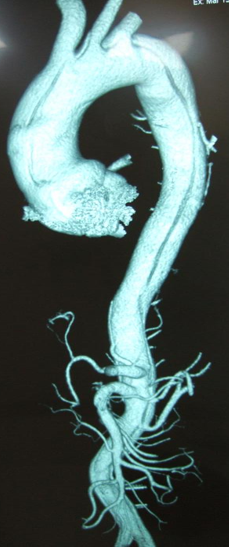 图1:A型主动脉夹层累及全主动脉
图1:A型主动脉夹层累及全主动脉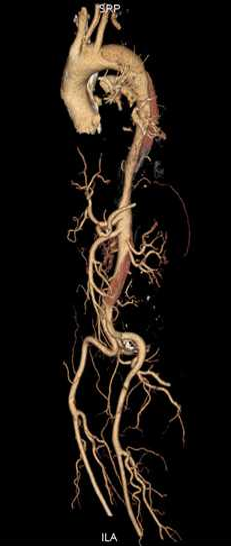 图2:B型夹层累及降主动脉以远
图2:B型夹层累及降主动脉以远 5、如何确诊主动脉夹层呢?
确诊主动脉夹层的主要辅助检查手段是:CT血管造影(CTA),磁共振检查(MRA)或是直接的数字剪影血管造影(DSA)。
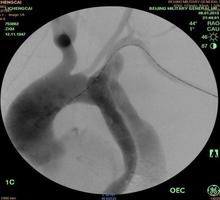 治疗前
治疗前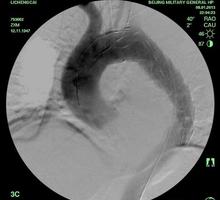 植入支架后
植入支架后 6、主动脉夹层怎么治疗呢?
1)保守治疗
对于急性夹层的患者,无论我们进一步要采取何种治疗手段,首先应进行相应的保守治疗:控制血压,控制疼痛。通常需要应用强有力的药物,如降压的硝普钠,镇痛的吗啡等。而对于情况危急的患者,往往需要急诊气管插管、呼吸机辅助呼吸,进行急诊抢救手术,但也意味着极高的风险和死亡率。
2)手术及介入治疗
在患者情况适当稳定后,治疗方式的选择主要根据夹层的类型而定。就目前的治疗现状而言,对于Stanford B型主动脉夹层,以微创腔内治疗为主。治疗的依据包括以下情况,或者说手术适应症:夹层持续扩大,表现为主动脉夹层直径快速增大、范围迅速增加、胸腔出血、疼痛无法控制;或是主动脉的主要分支,如肠系膜上动脉、肾动脉缺血。
传统的主动脉夹层微创腔内修复术在技术上要求主动脉上至少有1.5cm的锚定区,以防止近端封堵不完全,出现内漏。但是,随着腔内修复器材的改进和腔内修复技术的进步,这一指征已扩大,可以通过杂交手术或各种腔内修复巧术(烟囱、开窗、模块分支支架)来治疗主裂口距左锁骨下动脉开口1.5cm以内的Stanford B型主动脉夹层。
对于裂口位于升主动脉的Stanford A 型主动脉夹层腔内修复术有学者在升主动脉放置覆膜支架来隔绝近端夹层裂口,但这一术式需要特定的解剖条件限定。急性期行升主动脉置换术,孙氏手术仍是当前A型主动脉夹层的主要治疗方法。

